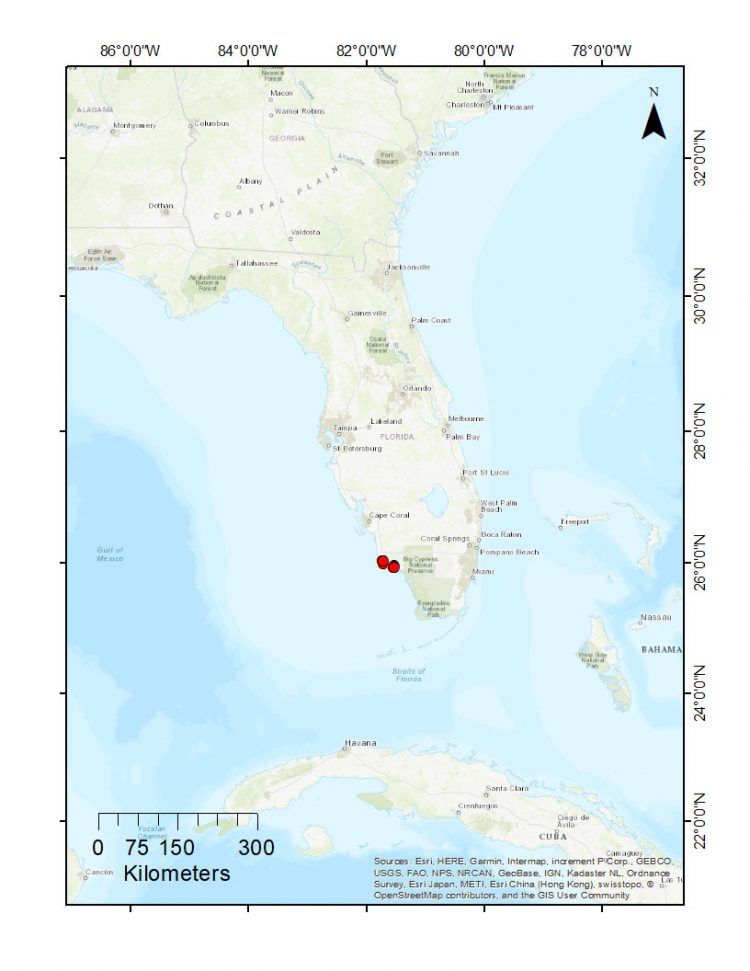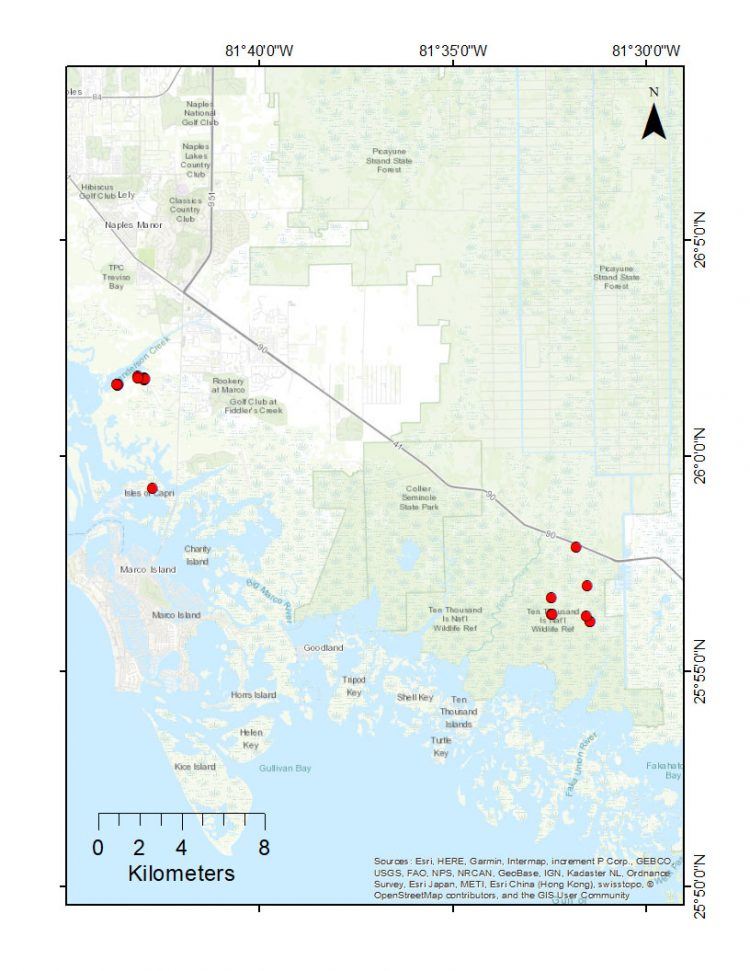Full Title: A Web-Based Interactive Decision-Support Tool for Adaptation of Coastal Urban and Natural Ecosystems (ACUNE) in Southwest Florida
This project developed a decision support tool to aid resource managers, municipalities, and a county with decisions related to the preservation and restoration of mangrove, marsh, and beach habitats; water management; and coastal planning, zoning, and land acquisition.
The Team: Y. Peter Sheng (Lead Investigator, University of Florida, pete@coastal.ufl.edu), Christine Angelini (University of Florida), Justin R. Davis (University of Florida), Vladimir A. Paramygin (University of Florida), Michael Savarese (Florida Gulf Coast University), Felix Jose (Florida Gulf Coast University), David Letson (University of Miami), Karen Thorne (U.S. Geological Survey), Ken Krauss (United States Geological Survey), and Michael Barry (The Institute of Regional Conservation)
Technical Monitor: Dave Kidwell (david.kidwell@noaa.gov) and Kassie Ernst (kathleen.ernst@noaa.gov)
Federal Program Officer/Point of Contact: Frank Parker (frank.parker@noaa.gov)
This project began in June 2017 and ended in November 2021.
Award Amount: $995,487
Why it matters: Southwest Florida contains the largest area of tidally influenced public lands in the Gulf of Mexico and the fastest growing urban landscape in Florida. Both the human and natural components of the ecosystem are under increasing risk due to the threats of a growing human population, sea level rise, and tropical cyclones. This decision-support tool was designed to aid resource managers with preservation and restoration of mangrove, marsh, beach habitats and adaptation of water management efforts to mitigate future saltwater intrusion in estuaries and their associated habitats.
What the team did: This was accomplished in two steps. First, a suite of coupled state-of-the-art models were used to create inundation, salinity distribution, habitat distribution, beach and barrier islands vulnerability, and economic impact maps for current and future climates and for various sea level rise scenarios specific to the region. The researchers then integrated the maps into an Adaptation of Coastal Urban and Natural Ecosystems (ACUNE) web-based interactive decision-support tool that enables users to identify areas of high vulnerability in many layers of interest.
Summary of Outcome:
Key projects accomplishments include:
- Co-developed a scientifically robust user-friendly ACUNE Geo Tool for adaptation planning by managers of local urban and natural systems, by utilizing the best available climate, coastal, ecological, and economic sciences, models, and data. Local stakeholders and NOAA technical managers have been actively engaged throughout the project.
- Developed the 1% annual chance coastal flood maps (including compound flooding by sea-level rise and tropical cyclones) and nuisance tide flood maps (including sea-level rise and tidal flooding) for current and future climate scenarios in 2030, 2060, and 2100.
- Assessed the ecosystem service value of coastal wetlands (mangroves, marshes, and woody wetlands) for buffering coastal communities from residential structural damage due to compound flooding by tropical cyclones and sea level rise in current and future climates.
- Provided in-depth training to managers of local urban and natural systems on the use of the ACUNE Geo Tool for assessing the vulnerability of future coastal flooding on various infrastructures and adaptation planning.
- Coastal communities and local governments, as well as neighboring communities (Lee, Charlotte, Pinellas, and Miami-Dade Counties) and other federal (USACE, USGS, USFWS) and state (Florida Department of Transportation, Florida Department of Environmental Protection, Florida Water Management Districts) agencies, have applied the current and future coastal flood risk to assessments and planning efforts in the region.
From the seminar “A Web-Based Interactive Decision-Support Tool for Adaptation of Coastal Urban and Natural Ecosystems (ACUNE) in Southwest Florida”
Presenter: Dr. Peter Sheng, University of Florida
Other Resources
- ACUNE Geo Tool
- Sharp, S., P. Norby, and C. Angelini. 2020. NOAA RESTORE Science Program: A web-based interactive decision-support tool for Adaptation of Coastal Urban and Natural Ecosystems (ACUNE) in southwest Florida: measured and laser-scanned vegetation structure from 2017-11-27 to 2017-12-02 (NCEI Accession 0222471). NOAA National Centers for Environmental Information. Dataset.
- Buffington, K., M. Barry, and K. Thorne. 2021. Wetland classification model developed with remotely sensed imagery obtained from the Sentinel-1 and -2 satellites and digitized species distribution maps for southwest Florida, coastal Gulf of Mexico, from 2010 to 2018 (NCEI Accession 0243071). NOAA National Centers for Environmental Information. Dataset.
- Davis, J.R., and T. Van Natta. 2022. NOAA RESTORE Science Program: A Web-based Interactive Decision-Support Tool for Adaptation of Coastal Urban and Natural Ecosystems (ACUNE) in Southwest Florida: Episodic Water Level Monitoring from 2018-06-10 to 2020-01-10. NOAA National Centers for Environmental Information. Dataset.
- Sheng, Y.P., V.A. Paramygin, and J.R. Davis. 2022. NOAA RESTORE Science Program: A Web-based Interactive Decision-Support Tool for Adaptation of Coastal Urban and Natural Ecosystems (ACUNE) in Southwest Florida: Flood Maps for current conditions, 2030, 2060, and 2100 under different sea level rise scenarios (NCEI Accession 0248802). NOAA National Centers for Environmental Information. Dataset.
- LEAN-Corrected Collier County DEM for wetlands developed by Kevin Buffington. Dataset.
- Tool helps prepare for sea level rise, coastal flooding in Collier County, Stephanie Byrne, WINK News, April 28, 2021.
- How nature can help SWFL fight back against sea-level rise, Evan Dean, NBC-2, May 25, 2021.
- Separating Climate Fact from Fiction in the Misinformation Age, WGCU’s Gulf Coast Live radio show, January 12, 2017.
- Curious Gulf Coast, pilot episode on WGCU-TV aired on October 26, 2017. Provided expertise on coastal resilience.
- Rising Seas Forum, presented by the Union of Concerned Scientists, Savarese as guest presenter. News Press, Ft. Myers, January 18, 2018.
- Southwest Florida Barrier Islands at Risk of Disappearing, NBC2 Fort Myers News, October 25, 2018.
- Le jour où la Floride sera sous l’eau (The day Florida is under water), Mathieu Magnaudeix, Mediapart, January 7, 2019.
- Representative Rooney Wants to Get Conservatives Talking About Climate Change, Andrea Perdomo, WGCU Radio, April 9, 2019.
- GOP Climate Hawk Francis Rooney Fights the ‘Political Winds’, Josh Siegel, Washington Examiner, April 12, 2019.
- Sea Level Rise is a Problem for the Future of Florida, David Trecker, News-Press, Fort Myers, April 23, 2019.
- Study shows Naples is in the top ten for cities to be underwater by 2100, Anna Kohls, Fox4 News, May 13, 2019.
- A climate change compact for Southwest Florida? Officials are starting to talk about it, Betsy Calvert, Charlotte Sun, June 16, 2019.
- Collier looks to computer models as officials gear up for sea level rise, severe storms, Patrick Riley, Naples Daily News, July 7, 2019.
- Putting politics aside to save our shore, Rachel Polansky, NBC2 Investigates, July 16, 2019.
- Climate change is creating ghost forests on Marco Island, Rachel Polansky, NBC2 Investigates, September 20, 2019.
- Completed coastal vulnerability study presented to council, Tiffany Repecki, Sanibel-Captiva Islander, October, 8, 2019.
- Climate change coalition for Southwest Florida: presentation made to Cape Coral’s City Council, story covered by: WINK News, Fox 4, and News-Press, October 8, 2019.
- Who will take up Francis Rooney’s environmental mantle? Advocates hope climate, water quality remain priorities, Amy Bennett Williams, Fort Myers News-Press. October 25, 2019.
- FGCU professor: climate change hitting SWFL; citizen action needed- updated, David Silverberg, The Paradise Progressive, October 24, 2019.
- Sanibel keeping an eye on water levels as climate change makes the island more vulnerable, Stephanie Byrne, WINK News, December 5, 2019.
- Five Things to Watch in Southwest Florida in 2020 (re: SWFL Compact development), Eric Staats & Harriet Howard Heithaus, Naples Daily News, January 1, 2020.
- Sanibel Begins Emergency Work to Keep Vital Roadway from Washing into the Gulf, Amy Bennett Williams, Fort Myers News-Press. January 14, 2020.
- City of Sanibel, FGCU Water School Team Up to Pinpoint Vulnerabilities of Sea-level Rise, Stephanie Byrne, WINK News. February 21, 2020.
- Public Meeting Held to Figure Out How To Protect Sanibel, Captiva from Sea-Level Rise, Stephanie Byrne, WINK News, February 28, 2020.
- A United Front: Community Leaders Talk Climate Change, Sea Level Rise, Chad Gillis, Naples Daily News, March 11, 2020.
- Florida’s Ancient Calusa Kingdom Was Powered by Ingenious Fish Corrals, George Dvorsky, Gizmodo, March 31, 2020.
- The Spread of Misinformation About COVID-19’s Impact on the Environment, Nina Mendes, Eagle News, April 20, 2020.
- Sanibel-Captiva Prepare for Projected Busy Hurricane Season, Stephanie Byrne, WINK News, June 3, 2020.
- City of Marco Island Joins Southwest Florida Regional Resiliency Compact, Audubon Florida, September 22, 2020.
- The Southwest Florida Regional Resiliency Compact, Ed Ryan interviewer, podcast for “Beach Talk Radio”, Fort Myers Beach, February 3, 2021.
- Geologist Explains How ‘West Captiva’ Sandbar Formed & If It’s Here to Stay, Alex Howard, NBC-2 News, February 24, 2021.
- FGCU Spearheading Efforts to Develop Tools to Prepare for Climate Change, Don Manley, Spotlight News Magazine, March 1, 2021.
- Southwest Florida Compact Moves Forward, Valerie Vande Panne, WGCU Radio, April 14, 2021.
- We Preview the 2021 Southwest Florida Climate Summit. WGCU Gulf Coast Life, April 26, 2021.
- Army Corps’ $2 Billion Storm Protection Plan to Shore Up Parts of Collier’s Coast Draws Concerns, Karl Schneider, Naples Daily News, April 27, 2021.
- Southwest Florida climate change resiliency group is forming, which will include Lee, Collier and Charlotte counties, Chad Gillis, News-Press, May 13, 2021.
- Working group seeks to make Sanibel a model in climate policy, Sanibel-Captiva Conservation Foundation, Sanibel Captiva Island Reporter, Islander & Current, June 8, 2021.
- How coastal communities are teaming up to fight climate change, Evan Dean, NBC-2, June 24, 2021.
- Major U.N. climate report warns of “extreme” and “unprecedented” impacts, Jeff Berardelli & Brea Hollingsworth, WINK News, August 9, 2021.
- Climate change: Researchers concerned for SWFL, managing infrastructure, Stephanie Byrne & Jack Lowenstein, WINK News, August 16, 2021.
- Water woes on tap at symposium as real estate pros look to ‘a light at the end of the tunnel’, Amy Bennett Williams & Laura Layden, USA Today Network and News-Press, September 8, 2021.
- Protecting Collier County’s coastlines: how commissioners plan to keep working with Army Corps, Karl Schneider, Naples Daily News, September 15, 2021.
- Climate & Community: Nuisance flooding – why not here?, Mike Savarese, Special to the News-Press and the Naples Daily News, September 29, 2021.
- Southwest Florida leaders come together for climate change, Karl Schneider, News-Press, October 8, 2021.
- Climate & Community: The worst manifestations of climate change are not inevitable, at least not yet, Mike Savarese, Naples Daily News, October 17, 2021.
- Resiliency compact members meet for first time, Beverly Bidney, Seminole Tribune, November 2, 2021.
- Time capsule could be lost to rising sea levels, Annette Montgomery, WINK-TV News, November 8, 2021.
- SWFL coastal communities more vulnerable to sea-level rise, Lauren Hope, Meteorologist for NBC-2 News, November 8, 2021.
- Vulnerable communities in SWFL expected to see more flooding as sea level rises, Samantha Serbin, NBC-2 News, February 10, 2022.
- NOAA report: sea levels on track to rise more than a foot by 2050, Andrew Shipley, FOX-4 News, February 17, 2022.
- SWFL to feel worse-than-average impacts of rapid sea-level rise, Emma Heaton, WINK-TV News, February 18, 2022.
- RESTORE Feature Story: Science-Stakeholder Partnership Leads to Broad Use of Decision-Support Tool in Southwest Florida, April 14, 2022
Sheng, YP, and Paramygin VA. 2022. ACUNE Overview. ArcGIS Story Maps.
 Official websites use.gov
A .gov website belongs to an official government organization in the United States.
Official websites use.gov
A .gov website belongs to an official government organization in the United States.
 Secure .gov websites use HTTPS
A lock or https:// means you’ve safely connected to the .gov website. Share sensitive information only on official, secure websites.
Secure .gov websites use HTTPS
A lock or https:// means you’ve safely connected to the .gov website. Share sensitive information only on official, secure websites.

